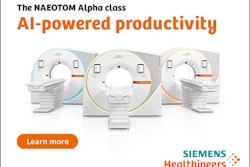In two of the first studies comparing generations of CT systems, 64-slice scanners appear to be the most accurate in detecting coronary vessel obstruction. While CT technology has advanced at a rapid pace, questions remain as to the diagnostic benefits of more sophisticated scanners.
The studies, presented at the 2006 American College of Cardiology (ACC) meeting in Atlanta, found clinically significant differences among 12-, 16-, and 64-slice scanners.
"Although investigations have explored the diagnostic performance of each CT imager in coronary applications, no studies have evaluated the diagnostic accuracy of such different generations of CT scanners simultaneously," according to Dr. Willem Meijboom, a research fellow at Erasmus Medical Center in Rotterdam, Netherlands.
His group compared the various multislice scanners (with 16-slice set to a lower rotation protocol) to quantitative coronary angiography in 204 patients. For the four-slice scanner, 26% of the segments were unevaluable due to poor image quality, compared to 7% of segments with the 12- and 16-slice scanners, and only 2% of segments with the 64-slice scanner.
False negatives occurred in up to 20% of four-slice diagnoses for coronary artery disease when unevaluable segments were included. None of the other scanners missed any coronary artery disease diagnoses. There were false positives in four out of 51 12-slice CT scans and one out of 51 16-slice CT scans.
Of note, 13 patients with acute coronary syndromes could be imaged with 64-slice CT because of the shorter scanning time. This "substantially increased number" of slices over previous generations of CT may permit 64-slice CT to "play a role as a sensitive 'gatekeeper' prior to invasive angiography," Meijboom said.
If you scan coronary patients, "you should have at least a 16-slice (scanner)," he added.
In the second study, 55 consecutive patients scheduled for invasive coronary angiography underwent 16- or 64-slice multidetector CT.
Lead author Dr. Yoshinobu Onuma from Mitsui Memorial Hospital in Tokyo agreed that the 64-slice system yields a clinically meaningful improvement in accuracy and "should be a useful gatekeeper of invasive coronary angiography."
In Onuma's study, significantly more segments were evaluable with the 64-slice CT: 97.2% compared to 87.4% with 16-slice. It also made the correct diagnosis in all patients, with a sensitivity of 94.4% versus 82.6% for 16-slice CT, and a specificity of 98.9% compared to 81.1% with the 16-slice CT.
Negative predictive value was 100% with both systems, but the positive predictive value was higher for the 64-slice CT (100% versus 84.2%), he said.
By Crystal Phend
AuntMinnie.com contributing writer
May 25, 2006
Related Reading
CTA narrows down plaque patterns in coronary arteries, May 8, 2006
CTA proves faster and cheaper for assessing chest pain in ER, April 11, 2006
CTA finds heart disease when calcium score is unreliable, April 5, 2006
64-slice CTA reliably detects stenoses by patient, less so by vessel and segment, March 23, 2006
Coronary CTA requires dedication, 64-slice minimum, November 30, 2005
Copyright © 2006 AuntMinnie.com




















